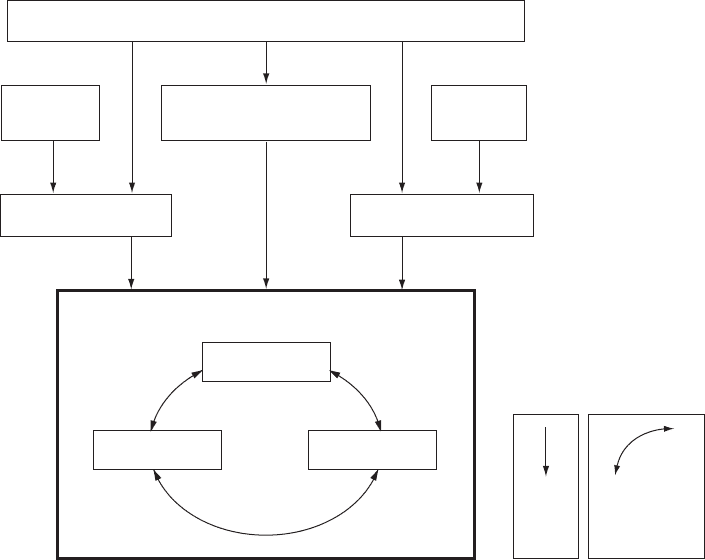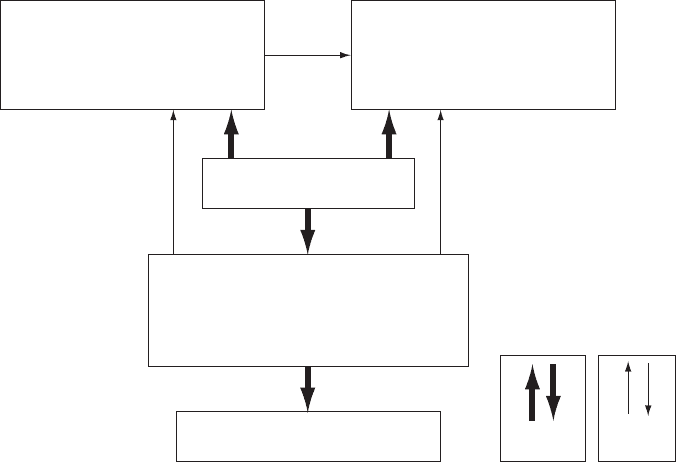Paul Hopkin. Fundamentals of Risk Management
Подождите немного. Документ загружается.


184 Risk and organizations
Monitoring and review
Is there suffi cient monitoring of performance using appropriate measurements?
•
Does the board challenge planning assumptions when and where appropriate? •
Does the board demonstrate the ability to respond rapidly to changes? •
Is there a mentality that demands continuous improvement in performance? •
Does the board assess fi nancial and other controls and seek assurance on •
compliance?
Performance and impact
Is there a satisfactory level of attendance at board, committee and other meetings?
•
Are board decisions and actions fully recorded and actions tracked and confi rmed? •
Are the established targets and agreed performance indicators evaluated and assessed? •
Is the impact of board decisions and actions evaluated in a timely manner? •
Is there an emphasis on accuracy, honesty and open reporting to external agencies • ?
The course of action will result in some outputs, and these need to be evaluated in terms of the
impact that is achieved. When evaluating the effectiveness of the board, the impact of its deci-
sions is the ultimate test. The level of impact can then be evaluated against the vision, mission
and objectives of the organization.
Table 19.3 continued
20
Stakeholder expectations
Range of stakeholders
Organizations will have a wide range of stakeholders, some of whom may indeed be unwanted
as far as the organization is concerned. For example, if a distribution company wishes to build
an extension to its depot, local residents may want to object to it. The local residents are stake-
holders in the operation of the company, even though the owner of the company may not wish
to acknowledge that fact. ISO Guide 73 defi nes a stakeholder as a ‘person or group concerned
with, affected by, or perceiving themselves to be affected by an organization’.
There will be a wide range of stakeholders in a typical sports club and these will include the
following:
supporters; •
players; •
staff; •
fi nanciers; •
sponsors; •
suppliers. •
Stakeholders may have contradictory expectations of the organization. For example, staff will
seek pay that is as high as possible. This would be in opposition to the requirements of fi nan-
ciers, who want the club to be as profi
table as possible. It is part of the role of management to
balance the confl
icting interests of different stakeholders and implement actions that provide
the best balance between confl icting stakeholder expectations.
For organizations in different sectors, the range of stakeholders will be different. For govern-
ment agencies, the general public will be a major stakeholder. Specifi c groups within the
general public will be stakeholders in different agencies, depending on the purpose of each
185

186 Risk and organizations
particular agency. For organizations that have signifi cant environmental interests or expo-
sures, a different range of stakeholders would need to be considered. For some energy compa-
nies, environmental pressure groups are often unwelcome stakeholders. There may be a
substantial confl ict between a mining company that wishes to extract minerals and the local
population who do not want heavy industrial activities taking place in the area.
Depending on the nature of the stakeholder, questions should be asked about the risk aware-
ness of the organization, the activities that are designed to achieve risk improvement and risk
governance arrangements within the organization. Relevant stakeholders are entitled to receive
information on the risk profi le of the organization. They are also entitled to information on
the arrangements for risk improvement and the metrics that are in place to monitor risk per-
formance. Finally, stakeholders are entitled to information on the risk appetite of the organi-
zation and the arrangements for incorporating risk into the development of strategy.
The box below provides an example of how stakeholders will have different expectations of an
organization. Sometimes, these expectations will be contradictory. Even if they are not contra-
dictory, it is helpful for one group of stakeholders to have an understanding of the expecta-
tions of the other groups.
Stakeholders in a theatre
Assume that a theatre is seeking to involve all stakeholders in its activities. This will
extend to consideration of the objectives of performers at the theatre, including artistes
and actors. There needs to be a distinction between the objectives of the performer and
the requirements of the audience. For example, an established musician may wish to
promote a new album, but the audience will want to hear the established favourites
from previous ones.
The performer will have the best chance of presenting a successful show if the starting
point is an evaluation of audience expectations, followed by an evaluation of the
expectations of the theatre. The performer can then plan the specifi c content of the
show to be consistent with those expectations as well as taking account of his or her
professional and personal objectives. The theatre may encourage this approach and
recognize the performer as a stakeholder, but encourage the performer to consider
other stakeholders and their expectations.
Stakeholder dialogue
Dialogue with stakeholders should be based on a mutual understanding of the objectives of
the organization. The board is responsible for ensuring that the dialogue is satisfactory.

Stakeholder expectations 187
Although specifi c members of the organization may have the day-to-day responsibility for
communications with particular groups of stakeholders, the board will retain overall respon-
sibility. Table 20.1 provides a summary of the information that should be provided to share-
holders of a company. This information will focus on the provision of accurate fi nancial
data.
The level and nature of dialogue with stakeholders will depend on the particular interests of
the stakeholder in the operations of the organization. The supporters of a sports club will
require different information than the banks that are providing the necessary fi nancial support
for the club.
To obtain the fullest picture of the risks facing an organization, analysis of stakeholders and
their expectations is necessary. The identifi cation of stakeholder expectations is one output
from the external evaluation stage of the business cycle. Different stakeholders may have
expectations that are contradictory or even mutually exclusive in terms of the demands placed
on the organization.
Table 20.1 Data for shareholders
General
A clear statement of strategy and vision
•
Corporate profi le and principal markets •
Financial data
Annual report and fi nancial statements
•
Archived fi nancial information for the past three years •
Corporate governance and CSR
Information related to compliance with Combined Code
•
Information on the company CSR policies •
Shareholder information
Shareholder analysis by size and constituent
•
Information on directors’ share dealings •
Relevant news
Access to all news releases and presentations
•
Developments that might affect the share value •

188 Risk and organizations
Stakeholders and core processes
Core processes deliver stakeholder expectations and they are related to the internal and exter-
nal context of the organization. Therefore, a risk can be defi ned as an event with the potential
to impact the fulfi lment of a stakeholder expectation. This approach has the advantage that
both internal and external stakeholders can be identifi ed, together with their short-term,
medium-term and long-term expectations. Figure 20.1 provides a graphical illustration of the
relationship between stakeholder expectations and the core processes of the organization. The
fi gure illustrates that the core processes of an organization can be strategic, tactical and opera-
tional. This classifi cation of core processes as strategic, tactical and operational is acknowl-
edged in British standard BS 31100 when it discusses risk management perspectives. Strategic
perspectives set the future direction of the business; tactical perspectives are concerned with
turning strategy into action by achieving change; and operational perspectives are related to
the day-to-day operations of the organization, including people, information security, health
and safety and business continuity.
Mission statement
Strategic or business plan
(and annual budget)
Strategic
TacticalOperational
Core processes
Internal
evaluation
Corporate objectives Stakeholder expectations
External
evaluation
Inuence Processes to
deliver business
model
(Figure 21.1)
Figure 20.1 Importance of core processes
Stakeholder expectations 189
An approach based on stakeholder expectations has many advantages. It facilitates a full and
thorough validation of the core processes of the organization in relation to the expectations that
each stakeholder places on each core process. An important aspect of managing an organization
is balancing the various stakeholder expectations. There are dangers inherent in achieving this
balance, and a risk identifi cation process based on analysis of stakeholder expectations is the
most robust way of ensuring that these dangers are recognized, analysed and minimized.
The analysis of stakeholder expectations is also one of the fundamental requirements of the
business process re-engineering (BPR) approach. The stakeholders in the current and future
activities of the organization can be identifi ed. The expectations of each stakeholder in relation
to each stated objective and the corporate mission can then be evaluated. Shared expectations
will emerge and the core processes of the organization can then be defi ned (or refi ned) spe-
cifi cally in terms of the delivery of these shared expectations.
Although the analysis of stakeholder expectations can be one of the most robust ways of iden-
tifying risks, there are implications in terms of the time and effort required for this approach
to be successful. BPR can be a very time-consuming exercise, when undertaken thoroughly.
Stakeholders and strategy
It has been clearly established and demonstrated by research that incorrect risk management
decisions related to strategy can destroy more value for an organization than incorrect risk man-
agement decisions associated with the operations or projects undertaken by the organization.
Strategic processes, therefore, need to be the most robust processes in the organization, and
indeed this will be required by major stakeholder groups. Such stakeholders include fi nanciers
and other shareholders who are interested in the long-term success of the organization.
Strategic core processes for a sports club may include the building of a new stadium. This would
be a signifi cant investment that will require substantial support from fi nanciers. In order to
secure support, the club will need to be aware of the expectations of the fi nanciers and ensure
that the plans for the new stadium and the fi nancial arrangements that will be put in place fulfi l
the necessary stakeholder expectations. The construction phase of acquiring a new stadium will
be a signifi cant project for the club, with a different range of stakeholders to consider.
Stakeholders and tactics
Tactical stakeholders of an organization may be very different from those who are concerned
with the organization’s operations.
190 Risk and organizations
If the tactics of an organization involve improvements to products, investment in new pro-
duction techniques, response to technological changes or other developments that require a
project, then fi nance is likely to be required. This means that fi nancial bodies are likely to be
key stakeholders in projects and similar tactical changes. Other stakeholders in projects may
include building contractors and providers of other specialist professional support, such as
architects.
The importance of employees in the implementation of tactics should not be underestimated.
Staff will also have an interest in operational issues and be major stakeholders in the organiza-
tion’s operations. If changes to work practices or product features are to be successfully incor-
porated into the operations of the organization, then the support of staff is vitally important
and good communication with them is essential.
Stakeholders and operations
There may be many stakeholder groups involved in the operational activities of an organiza-
tion. To continue with the example of a sports club, fans will be major stakeholders in a large
number of different aspects of the club’s activities. One of the primary concerns of fans will be
good results on the pitch. They will also be interested in other operational aspects, including
the arrangements for buying tickets, transport and access arrangements, as well as the facilities
provided within the stadium.
Pharmaceutical companies are generally large organizations with a very diverse range of
stakeholders. In particular, a pharmaceutical company producing a critical medication has
an obligation to ensure a constant availability of that medication for all its patients. Patients
should be viewed by the pharmaceutical company as important stakeholders who have
expectations regarding the availability and effectiveness/effi cacy of the medication that has
been prescribed.
The stakeholder groups that have an interest in the operational activities of an organization
are likely to be customers, suppliers and others that may be affected by disruption to the
normal effi cient operation of the organization. For example, customers are likely to be affected
if a hazard risk were to materialize. Likewise, suppliers are stakeholders in the organization
and they will suffer if the organization is disrupted to the extent that their supplies/produce/
components/service are no longer required.
Other stakeholder groups that are likely to be affected by hazard risks will also have an interest
in the continuity of the activities of the organization. For fi nancial organizations such as banks,
customers would be immediately affected if critical IT systems fail.
Corporate governance models require the involvement of stakeholders and adequate
stakeholder dialogue. In several countries, employees are recognized as stakeholders in

Stakeholder expectations 191
the organization to the extent that employee representation on the board may be manda-
tory. The box below considers the position in some European countries.
Employee representation on the board
Board-level employee representation involves employee representatives who sit on the
supervisory board, board of directors or similar structures in companies. These
employee representatives are directly elected by the workforce, or appointed in some
other way, and may be employees of the companies, offi cials of organizations
representing those employees, or individuals considered to represent the employees’
interests in some way.
Board-level representation also differs from other types of indirect participation such
as works councils in that it attempts to provide employee input into overall company
strategic decision making rather than focusing on information and consultation on
day-to-day operational matters at the workplace.
In most cases in western Europe, employee representatives are in the minority, and
board-level participation is associated with the obtaining of information and
understanding and the expression and exchange of opinions, views and arguments
about an enterprise’s strategy and direction. In a few cases, however, when employee
representatives are equal in number to those of shareholders or other parties, issues of
control, veto and real infl uence over company strategy – sometimes known as
‘co-determination’ – come into play.
21
Analysis of the business model
Simplifi ed business model
In order to place risk management within the context of business operations, it is necessary to
consider a simplifi ed business model. Figure 21.1 sets out the basic elements of a business
model in simple terms. The fi rst stage for an organization is to decide the strategy that it is
seeking to deliver. The strategic aims will be determined by considering the mission statement
of the organization, the corporate objectives and the stakeholder expectations. The organiza-
tion should establish a strategy that is capable of delivering the mission statement of the organ-
ization. In other words, the strategy of the organization needs to be effi cacious.
Having established the overall strategy, the processes that will deliver it need to be identifi ed.
For many organizations, the processes that are already in existence will be suffi cient. However,
if the strategy requires changes to processes or the introduction of new processes, then projects
or programmes of work will be required. The processes introduced by the organization should
be effective in that they are the correct processes to deliver the desired outcomes in the most
cost-effective manner.
The operations of the organization will need to be effi cient in that they deliver the required
and anticipated outputs at the lowest cost with least disruption. The operations of the organi-
zation are the day-to-day operations that build into the processes that deliver the overall strat-
egy for the organization. In relation to operations, the desired state of the organization is the
continuity of normal effi cient operations with no unplanned disruption.
Figure 21.1 sets out the stages that are described above. The strategy can be seen as ‘where the
organization wants to be’. Review of the operations of the organization will collect informa-
tion on ‘where the organization is now’ and the tactics defi ne ‘how the organization will get
there’. This is a three-stage business model that has events at its centre. In many circum-
stances, these events will represent risks that could materialize. The other component of this
simple business model is the reporting of the results of operations.
192

Analysis of the business model 193
4. Events
(what happens along the way)
5. Results of Operations
(how well the organization is doing)
2. Operations
(where the organization is now)
1. Strategy
(where the organization wants to be)
• Efcacious strategy
• Three-year strategic plan
• Annual budget
• Efcient operations
• No disruption or failure
• Competitive advantage
3. Tactics
(how the organization will get there)
• Effective processes
• Programme design
• Project management
Impact or
Attach
Support or
Deliver
Figure 21.1 Simplifi ed business model
Actions and events can be good, bad or routine, and enable the organization to monitor what
progress is being made against the business strategy, projects and operations. These actions
and events impact the organization and its ability to sustain effi cacious, effective, effi cient and
compliant business operations and core processes.
Identifi cation of strategy will require an approach based on opportunity management. Deliv-
ery of tactics, often by way of projects, will require attention to uncertainties and management
of control risks will be important. Delivery of effective and effi cient operations will require
particular attention to the successful management of hazard risks.
Core business processes
A core process is one that is fundamental to the continued success (or even existence) of the
organization. Core processes ensure that the organization is able to achieve the mission and
corporate objectives and fulfi l stakeholder expectations. Each core process creates value and is
designed to deliver one or more of the stakeholder expectations.
There are three basic types of core process as set out in Figure 20.1 (page 188). These are proc-
esses designed, implemented and managed to ensure the following:
development and delivery of strategy; •
